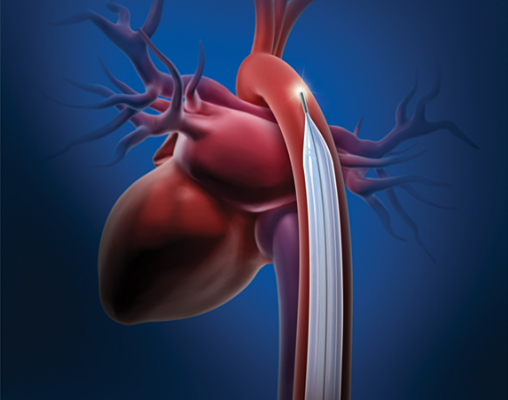IABP: Intra-Aortic Balloon Pump in Cardiac Care – Benefits and Applications
The Intra-Aortic Balloon Pump (IABP) is a vital device used in cardiac care to support patients with compromised heart function. This comprehensive guide explores the significance, applications, benefits, and working principles of the IABP.

Understanding the Intra-Aortic Balloon Pump (IABP)
Keywords:
What is IABP, Intra-Aortic Balloon Pump overview, IABP device
The Intra-Aortic Balloon Pump, commonly known as IABP, is a mechanical device designed to assist the heart’s pumping function. It consists of an inflatable balloon that is inserted into the aorta, the largest artery in the body. The IABP is synchronized with the patient’s heartbeat to provide enhanced cardiac support.
How Does the IABP Work?
Keywords:
IABP mechanism, Cardiac support device, Balloon pump operation
The IABP operates based on counterpulsation. During the cardiac cycle, the balloon is deflated, allowing the heart to eject blood more effectively. As the heart relaxes, the balloon inflates, creating a temporary increase in aortic pressure. This process enhances coronary artery perfusion and reduces the heart’s workload, improving overall cardiac function.
Indications for IABP Usage
Keywords:
IABP indications, Heart failure treatment, Cardiogenic shock management
The IABP is utilized in various clinical scenarios, including:
Acute Heart Failure:
When the heart struggles to pump blood effectively, the IABP can provide mechanical support.
Cardiogenic Shock:
In cases of severe heart dysfunction, the IABP helps stabilize blood pressure and cardiac output.
Coronary Artery Bypass Surgery:
IABP may be used during and after surgery to enhance circulation and recovery.
Benefits of IABP Therapy
Keywords:
IABP advantages, Cardiac support benefits, Heart function enhancement
IABP therapy offers several potential benefits for patients with compromised heart function:
Enhanced Cardiac Output:
By reducing the heart’s workload, IABP helps improve the heart’s ability to pump blood.
Coronary Artery Perfusion:
Increased aortic pressure during diastole enhances blood flow to the coronary arteries.
Stabilization in Critical Conditions:
IABP can stabilize patients with cardiogenic shock, buying valuable time for further treatment.
How IABP is Implanted
Keywords:
IABP insertion procedure, Balloon pump placement, Cardiac device implantation
The insertion of an IABP involves a medical procedure where the balloon-tipped catheter is threaded into the aorta through a blood vessel (usually the femoral artery). Once positioned, the balloon is inflated and deflated in sync with the heartbeat. The procedure is conducted by experienced medical professionals and may require imaging guidance.
Monitoring and Management with IABP
Keywords:
IABP monitoring, Patient care with balloon pump, Continuous assessment
Patients undergoing IABP therapy require close monitoring to ensure optimal outcomes:
Hemodynamic Monitoring:
Blood pressure, heart rate, and other parameters are continuously assessed.
Balloon Timing Adjustment:
The balloon inflation and deflation timing may be adjusted to match changes in the patient’s condition.
Patient Education:
Patients and their caregivers are educated about device management and potential complications.
Complications and Considerations
Keywords:
IABP complications, Balloon pump risks, Patient safety
While IABP therapy is generally safe and effective, there are potential complications to be aware of:
Vascular Issues:
Insertion site bleeding or damage to blood vessels can occur.
Infection Risk:
Invasive procedures carry a risk of infection at the insertion site.
Balloon Rupture:
Rarely, the balloon can rupture, requiring immediate medical attention.
Patients and healthcare providers must carefully weigh the benefits against potential risks.
Future Developments in Cardiac Support
Keywords:
Advances in cardiac support, IABP innovation, Cardiology technology
The field of cardiac support devices is rapidly evolving. Researchers continue to explore new technologies that may enhance heart function and patient outcomes. These developments offer hope for even more effective treatments in the future.
Frequently Asked Questions about IABP
1. Is IABP surgery?
Answer: IABP insertion involves a medical procedure but is not considered surgery.
2. How long is IABP treatment typically required?
Answer: Duration varies based on the patient’s condition. It can be several days to a few weeks.
3. Can I move around while using IABP?
Answer: Limited mobility is advised to prevent dislodging the catheter. Follow medical guidance.
4. Can I eat normally with the IABP in place?
Answer: Dietary restrictions are minimal. Follow your healthcare provider’s advice.
5. Are there any lifestyle restrictions during IABP therapy?
Answer: Light activity is usually recommended, but consult your doctor for personalized guidance.
6. How will I know if the IABP is working effectively?
Answer: Regular monitoring and communication with medical staff ensure optimal performance.
7. Is IABP a long-term solution for heart problems?
Answer: IABP is often used as a short-term measure while underlying issues are addressed.
8. Are there alternatives to IABP for cardiac support?
Answer: Other devices like ventricular assist devices (VADs) are available but have different mechanisms.
9. What is the success rate of IABP therapy?
Answer: Success depends on the patient’s condition and timely intervention.
10. Can I resume normal activities after IABP removal?
Answer: Gradual resumption of activities is advised. Follow medical advice
Conclusion
The Intra-Aortic Balloon Pump (IABP) stands as a crucial innovation in the realm of cardiac care. Its ability to enhance heart function, stabilize patients in critical conditions, and provide temporary support is invaluable. While the IABP comes with considerations, its potential benefits have made it a cornerstone in the management of certain cardiac conditions.




